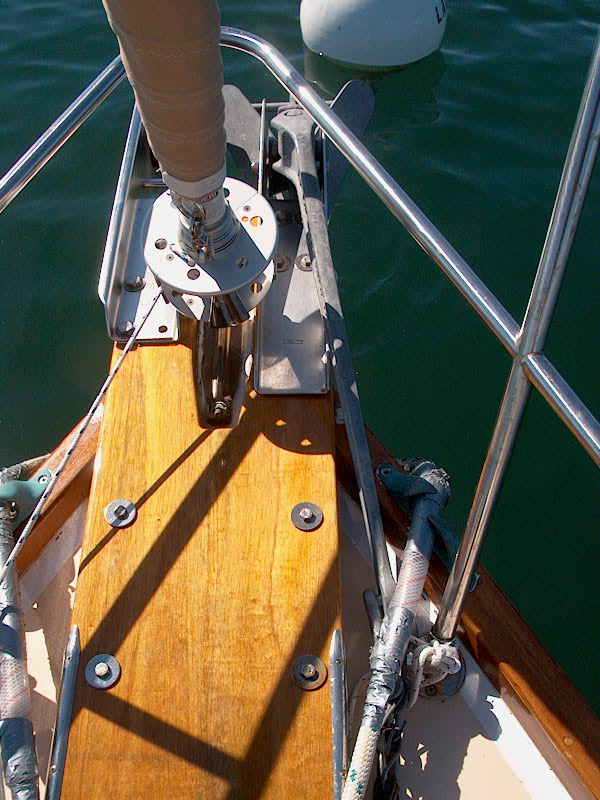|
Anchoring Setup and Ground Tackle (Page 4)
This page was last updated on June 14, 2002
After the original anchor platform was
destroyed while the boat rode out a storm in May 2002--which damage also caused
one anchor roller to be lost and some unsightly damage to the hull--I was forced
to think about the causes of the problem, and to come up with a way to more or
less ensure that the same thing would not happen again.
The
new anchor platform nearly duplicates the original in shape, size, and
overall function. However, it is significantly stronger thanks to the
integral addition of a 3/8" thick stainless steel plate to reinforce the part
that hangs over the bow. This should prevent breakage of the platform as
happened before. But what about the overhanging anchors? Did the
mooring line really hook itself over the CQR anchor, which in turn caused the
platform to break? Was it a complete against-all-odds event, or might the
same thing tend to happen again someday under similar circumstances?
My informal research and
observation of other boats seemed to indicate that my platform was not unusual,
or the way the anchors hung off unorthodox in the slightest. In fact, it
seems that many boats are even more susceptible to this sort of problem than I
would have said Glissando is.
Two things were different about
my anchor setup for 2002 vs. 2001.
1. The CQR roller, and
its anchor, were protruding farther out, away from the platform, than last year.
This was necessary because of the conflict with the new Bruce anchor roller and
anchor that I installed in the spring of 2002. Perhaps this placed the
fluke of the CQR out in an area more susceptible to grabbing that mooring line
when the boat pitched in heavy seas.
2. The mooring line
chocks were closer to the stem in spring 2002 than 2001; I had moved them during
spring commissioning because I thought the lead would be better if they were
farther forward. The net effect of this was to narrow the opening between
the dual mooring lines--could this slight narrowing have caused the lined to be
more susceptible to hooking that anchor?
 Did
these two seemingly insignificant changes have anything to do with what
occurred? I will never know for sure. However, one of the first
things I did during my reconstruction of the anchor platform and repair of the
deck was move the chocks back to their original location from last year. I
was also able, during the construction of the new platform, to move the CQR
roller back to its position from 2001, despite the 2nd anchor and the
interference thereunto. Mocking up the two rollers and anchors during
construction made this placement easy. I'm not sure why it was a problem
back in the spring, but it definitely was. Did
these two seemingly insignificant changes have anything to do with what
occurred? I will never know for sure. However, one of the first
things I did during my reconstruction of the anchor platform and repair of the
deck was move the chocks back to their original location from last year. I
was also able, during the construction of the new platform, to move the CQR
roller back to its position from 2001, despite the 2nd anchor and the
interference thereunto. Mocking up the two rollers and anchors during
construction made this placement easy. I'm not sure why it was a problem
back in the spring, but it definitely was.
With the new platform complete,
I installed the CQR with some trepidation. How could I arrange the thing
so that the fluke would not be in the way? I have seen some of these
anchors stored on their side, with the flukes tied up to the pulpit or
something. That's OK, but kind of awkward, and it still seemed, on my
boat, that things were in the way.
At first, I ran the anchor
shank down to deck level, off to the side. This seemed to work well from a
storage standpoint, and I could easily tie the end of the shank to the nearby
pulpit to secure it. However, this tended to cause the point of the anchor
to extend farther downward--just what I really didn't want. However, for
general storage purposes--such as during our upcoming cruising--this seems like
a very good storage method, and it also keeps the shank out of the way of the
furling drum and the mooring line.
|